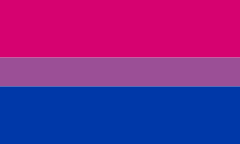Bisexual pride flag
The bisexual pride flag was designed by Michael Page in 1998 in order to give the bisexual community its own symbol comparable to the gay pride flag of the larger LGBT community. His aim was to increase the visibility of bisexuals, both among society as a whole and within the LGBTQ+ community. The first bisexual pride flag was unveiled at the BiCafe's first anniversary party[1] on December 5, 1998.[2]
.jpg)

| Part of a series on |
| Bisexuality topics |
|---|
| Related sexual orientations |
| Sexual identities |
| Studies |
| Attitudes and discrimination |
| Bisexual community |
| Lists |
|
| Portals |
|
| LGBT symbols |
|---|
| Flags |
| Other symbols |
The colors chosen above were used as so: The pink is for same sex/gender attraction, blue is for different sex/gender attraction, and purple is to represent the attraction across the gender spectrum.
Design & colors
Page took the colors from an existing bisexual symbol and gave it his own spin, saying
In designing the Bi Pride Flag, I selected the colors and overlap pattern of the 'bi angles' symbol.[3]

Biangles, or bisexuality triangles, are another symbol for the bisexual community with unclear origins. The crescent moon symbol is another symbol for bisexuality that deliberately avoids the imagery of the pink triangle.[4][5]
Page describes the meaning of the pink, lavender, and blue (ratio 2:1:2) flag[1] as this: "The pink color represents sexual attraction to the same sex only (gay and lesbian). The blue represents sexual attraction to the opposite sex only (straight) and the resultant overlap color purple represents sexual attraction to both sexes (bi)."[3][6]
Page describes the flag’s meaning in deeper terms, stating "The key to understanding the symbolism of the Bisexual pride flag is to know that the purple pixels of color blend unnoticeably into both the pink and blue, just as in the 'real world,' where bi people blend unnoticeably into both the gay/lesbian and straight communities."[4]
The flag is used in different aspect ratios. 2:3 and 3:5 are often used, in common with many other flags; on the (now closed) website biflag.com 3:4 was specified as the "exact ... proportions" of the "original Bi Pride flag".
The stripe colors and widths, from top to bottom, are pink (40%), purple (20%), and blue (40%).[3] The exact colors given by the designer are: PMS 226, 258, and 286.[1] Their approximate HTML values are #D60270, #9B4F96, #0038A8;[7] their approximate RGB values are (214,2,112), (155,79,150), and (0,56,168), respectively.[8] It is not patented, trademarked, or service marked.[3]
Licensing controversy
In 1998, Page stated that the bisexual pride flag was "for free public and commercial use" and that it was "not patented, trademarked or service marked."[3] In April 2020, BiNet USA claimed that it was the sole copyright owner of the flag and flag colors, and said organizations and individuals who wished to use the flag for commercial purposes would be required to obtain a license from the organization.[9] BiNet's claim and the resulting controversy were covered by Out and LGBTQ Nation, which cast doubt on BiNet's claim and noted that the flag is not eligible for copyright.[9][10]
On April 29, 2020, BiNetUSA made a tweet claiming the Wikipedia page for the bisexual pride flag was inaccurate.[11] BiNetUSA ultimately ceased to use the flag on May 8th, opting instead to use a different design.
See also
- Bisexual American history
- Bisexual community
- Celebrate Bisexuality Day
- LGBT symbols
References
- Young, Randy (June 6, 2015). "BiPride Flag". Flagspot. Flags of the World. Retrieved October 24, 2015.
- http://www.wright.edu/counseling/SafezoneSymbols.html
- "History, Bi Activism, Free Graphics". BiFlag.com. December 5, 1998. Archived from the original on August 1, 2001. Retrieved April 20, 2020.
- Petronzio, Matt (June 13, 2014). "A Storied Glossary of Iconic LGBT Flags and Symbols". Mashable. Mashable, Inc. Retrieved October 24, 2015.
- "Pride Symbols and Icons". Association for Lesbian, Gay, Bisexual, and Transgender Issues in Counseling of Alabama. ALGBTICAL. Retrieved October 24, 2015.
- Rosiek, Jerry (2005). "Rainbow Flag and Other Pride Symbols". In Sears, James Thomas (ed.). Youth, Education, and Sexualities: An International Encyclopedia. 2. Westport, Conn.: Greenwood. p. 701. ISBN 0-313-32755-6.
- "Pantone color conversion chart at goffgrafix.com". Archived from the original on November 12, 2016. Retrieved May 20, 2012.
- HEX to RBG Conversion Tool at Colorrrs.com
- Bollinger, Alex (April 29, 2020). "A group is threatening legal action & demanding payment for use of the bisexual pride flag". LGBTQ Nation. Retrieved April 29, 2020.
- Street, Mikelle (April 29, 2020). "This Organization Wants to Be Paid for Use of the Bi Pride Flag". www.out.com. Out. Retrieved April 29, 2020.
- @BiNetUSA (April 29, 2020). "Hey @Wikipedia can you help us with this page called Bisexual Pride Flag? Ita wholly inaccurate; and we can put you in touch with "Michael Page" who identified the info was wrong. Also he said he is not bisexual and doesn't want to be associated with the flag. Can you help?" (Tweet). Retrieved May 4, 2020 – via Twitter.